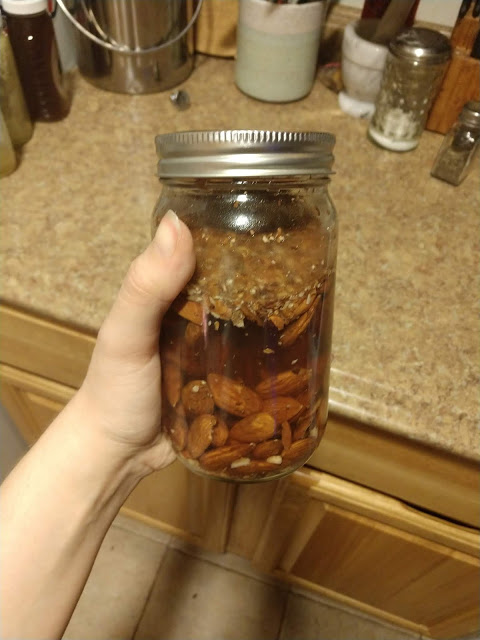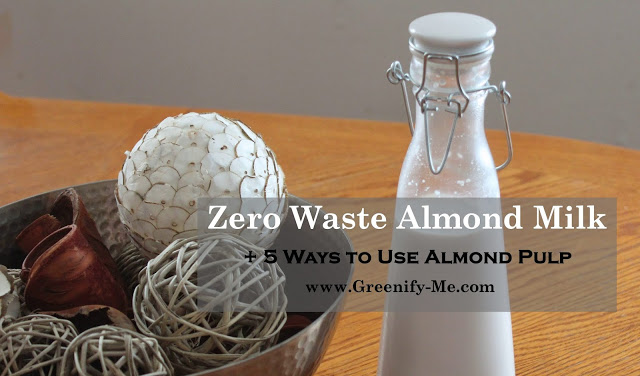I finally decided to give in and make some zero waste almond milk. Normally, I stick to making cashew milk (it’s quicker and doesn’t require any straining), but I wanted to switch things up. So, I went to the bulk food store, grabbed some raw almonds, and got busy. This is my first time making almond milk, and I think it turned out pretty good. It does require a lot of patience and straining, but once you taste that almond milk it’s like “oh, right, that’s why people do this.” It’s just so good. The only problem is figuring out what to do with the leftover nut pulp. Thankfully, that stuff is pretty useful and there are a bunch of recipes you can use it in, believe it or not. I’m planning on turning mine into almond flour, or turning it into almond pulp hummus. At the end of the article, I talk about more ways to use almond pulp so be sure to check that out. You don’t want to go wasting it – it’s very useful!
Zero waste almond milk tastes so much better than store bought, it’s cheaper, and is obviously plastic free. I’m guilty of buying almond milk in plastic cartons, I admit it. While New York state does recycle that sort of plastic, it isn’t something I want to contribute to (since only 9 percent of plastic actually gets recycled). So, I’ve either been going milk-free altogether, or making my own. I’m not sure I will adopt making almond milk on a constant basis (I much prefer the easy, quick nature of cashew milk), but at the very least I know how to do it now. Also, it’s important to note I didn’t strain this with a nut milk bag. I just used a piece of cheesecloth. You can also use a fine mesh produce bag, if that’s all you have. Heck, you could even use pantyhose if you were desperate enough I suppose. Just something to strain the nut pulp from the milk. I recommend straining it at least once or twice to get all of the fine almond pulp out.
This recipe is rather straight forward: Soak the almonds, rinse them, puree them and strain them. That’s it. The hardest part is honestly waiting for the almonds to finish soaking (since they need to soak for over 12 hours). That and dealing with the messy nut pulp, but hey. Totally worth it. This almond milk is probably the most pure, potent tasting milk you’ll ever taste. It goes great in cereal, oatmeal, coffee, or anything else you typically use almond milk in. It adds a lot of body and flavor to a meal, that’s for sure. Ready to give it a try? Without further ado, here’s how to make zero waste almond milk and five ways to use almond pulp.
____________________________
Zero Waste Almond Milk
Zero Waste Recipe
- 1 cup of raw, organic almonds (preferably bought package free at the bulk bins)
- 2 cups of water (for pureeing + more water for soaking)
- 2 to 3 tablespoons of sugar, honey or maple syrup (optional – can also use one or two dates)
- 1 teaspoon of vanilla extract (optional)
 |
| Me, soaking the almonds. Just added the water in this picture. |
Directions:
- Place your almonds in a glass jar and cover them with water (I used a 16 oz mason jar and covered them a little more than halfway with water). Place the lid on the jar and set it aside, letting the almonds soak for 12 to 48 hours.
- Strain the almonds and rinse them off well. Make sure not to drink the water the almonds were soaking in (you can use it to water your plants though). Add the almonds and 2 cups of fresh water to a blender (or food processor) and blend for at least a minute, if not more.
- Grab the container you’d like to store your almond milk in. Grab a funnel and cover it with a piece of cheesecloth. Pour the almond mixture through, gathering together the edges of the cloth to form a ball and squeeze out as much almond milk as possible. This may get a little messy, FYI.
- Inside the cheesecloth, you’ll find your almond pulp. Save this for later (I have some great uses for it I’ll be sharing with you down below). I put all of my almond pulp into a glass jar, but you can store it in a bowl.
- If you’d like to sweeten the almond milk, add some sugar, honey, maple syrup to the mix now. If you’d like to use dates to do this, return your almond milk to the blender, add the dates and puree once more. You can also add the vanilla extract at this time, if you so choose, for added flavor. Personally, I skipped on the vanilla and mixed in some honey. It came out delicious.
 |
| Just finished making the almond milk and putting all the pulp into a glass jar. |
That’s it! Not too bad, right? It’s one of the most pure tasting almond milks you’ll ever try, that’s for sure. Plus, the almond pulp is an added bonus, considering you can use it to make so many different things.
If you find yourself running out and would like to thin out your batch a little bit, feel free to add some filtered water to it. It’ll prolong the life of your milk a little further, without you having to make a new batch.
That said, if you’re intimidated by how long it takes to soak the almonds, or using up the nut pulp, I highly recommend making
homemade cashew milk instead. Much quicker process, and such a rich, creamy milk.
Storage options: Keep zero waste almond milk in the fridge at all times. I stored mine in a glass bottle with a ceramic lid. Any glass container should do nicely though, as long as it’s sealed shut nice and tight. Be sure to use up your nut milk quick though, as it easily spoils. I recommend using it up within 4 days or so.
____________________________
5 Ways to Use Almond Pulp
Now that you know how to make zero waste almond milk, you also know it comes with almond pulp. Technically, you can just compost it and be done with it, but why waste something you can use in your next meal? Here are five ways to use almond pulp you might not have expected.
1. More almond milk – Yup. Pretty straight forward. Just return the pulp to the blender, add another cup of water (or a cup and a half) and repeat the process. This second batch will definitely be a lot more water down than the first, but still yummy. If you like your nut milk light, less rich and less potent, it’s a great way to put the pulp to work.
2. Almond flour – Almond flour tends to be pretty pricey on supermarket shelves. It also tends to come in plastic packaging. Ironic, considering it’s so easy to make at home for practically nothing. Just put it onto a baking sheet (no grease or parchment paper needed) and break it up using a fork. Bake the pulp in the oven at around 225 degrees F, or until completely dried out. Make sure to stir the pulp every 30 minutes or so to break up lumps, or prevent sticking. Blend the dried pulp up in a blender or food processor. You now have almond flour. Use it to make any baked goods you enjoy.
3. Healthy almond pulp bread crumbs – To make almond pulp bread crumbs, you’d do the same steps I suggested above for making almond flour, only without blending the dried pulp. Once the pulp is dry, you’d just crumble it up with your hands and store it in the fridge. Use it in any recipes that call for bread crumbs. As an added bonus, they’re gluten free!
4. Almond pulp hummus – I love hummus. I really do. But the legumes and beans in hummus do not always agree with my digestive track. Thankfully,
almond pulp hummus exists…and thanks to the classic hummus flavors like tahini, garlic and olive oil, it tastes just as good.
5. Almond milk pulp cheese – If you enjoy eating vegan cheese, you’re going to love this one. Almond pulp has a ricotta-like texture so it’s great for this. You can mix almond pulp into your favorite herbs and spices, then chill and shape it into balls or logs. This
almond milk pulp cheese doesn’t require any additional baking either, making it a quick, no bake recipe to follow.
Would you give this zero waste almond milk a try? How do you like to use up the almond pulp that comes with it? Leave a comment to let me know.
If you enjoyed this article, be sure to share it! If you like my content, sign up for my newsletter to get notified every time I write a new blog post.







How long do the bread crumbs keep for would you say? Thanks for the recipe!
That’s a really good question! I’ve yet to try that one out, but I’d guess it’d be good for at least a week if kept in the fridge? Happy this helped you!